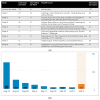Weight-Dependent Disparities in Adolescent Girls: The Impact of a Brief Pilot Intervention on Exercise and Healthy Eater Identity
- PMID: 29973565
- PMCID: PMC6068924
- DOI: 10.3390/ijerph15071411
Weight-Dependent Disparities in Adolescent Girls: The Impact of a Brief Pilot Intervention on Exercise and Healthy Eater Identity
Abstract
Adolescent girls report low participation in healthy behaviors (e.g., nutritious eating and exercise), and are disproportionately affected by obesity. Short-term interventions, such as behavioral summer camps, may positively influence psychological underpinnings of healthy behavior, particularly exercise identity (EI) and healthy eater identity (HEI). The present study investigates disparities and changes in identity and subsequent health behavior in two cohorts of adolescent girls following a brief, multicomponent intervention. A sample of normal-weight adolescent girls from a health promotion camp and an elevated body mass index (BMI) sample from an obesity treatment camp participated in the study. Both camps ran one-week in duration and delivered comparable intervention components. All families were given access to the same eight-week eHealth program post-camp. Significant EI and HEI role-identity disparities between the health promotion and obesity treatment cohorts were apparent at baseline. Following the one-week camp intervention, EI and HEI scores increased in both groups. At follow-up, the treatment group had increased EI and HEI role-identities in such that the groups no longer significantly differed. Positive changes in health behaviors were experienced in each group. This pilot study demonstrates that EI and HEI differ between normal-weight and obese adolescent girls and weight-dependent identity disparities may be mitigated following brief, multicomponent interventions.
Keywords: adolescents; diet; health behavior; health disparities; identity; obesity; physical activity.
Conflict of interest statement
The authors declare no conflicts of interest.
Figures



References
-
- Van Grieken A., Renders C.M., Wijtzes A.I., Hirasing R.A., Raat H. Overweight, obesity, and underweight is associated with adverse psychosocial and physical health outcomes among 7-year-old children: The “be active, eat right” study. PLoS ONE. 2013;8:e67383. doi: 10.1371/journal.pone.0067383. - DOI - PMC - PubMed
-
- Webber L.S., Catellier D.J., Lytle L.A., Murray D.M., Pratt C.A., Young D.R., Elder J.P., Lohman T.G., Stevens J., Jobe J.B., et al. Promoting physical activity in middle school girls: Trial of Activity for Adolescent Girls. Am. J. Prev. Med. 2008;34:173–184. doi: 10.1016/j.amepre.2007.11.018. - DOI - PMC - PubMed
Publication types
MeSH terms
LinkOut - more resources
Full Text Sources
Other Literature Sources
Medical
Miscellaneous

